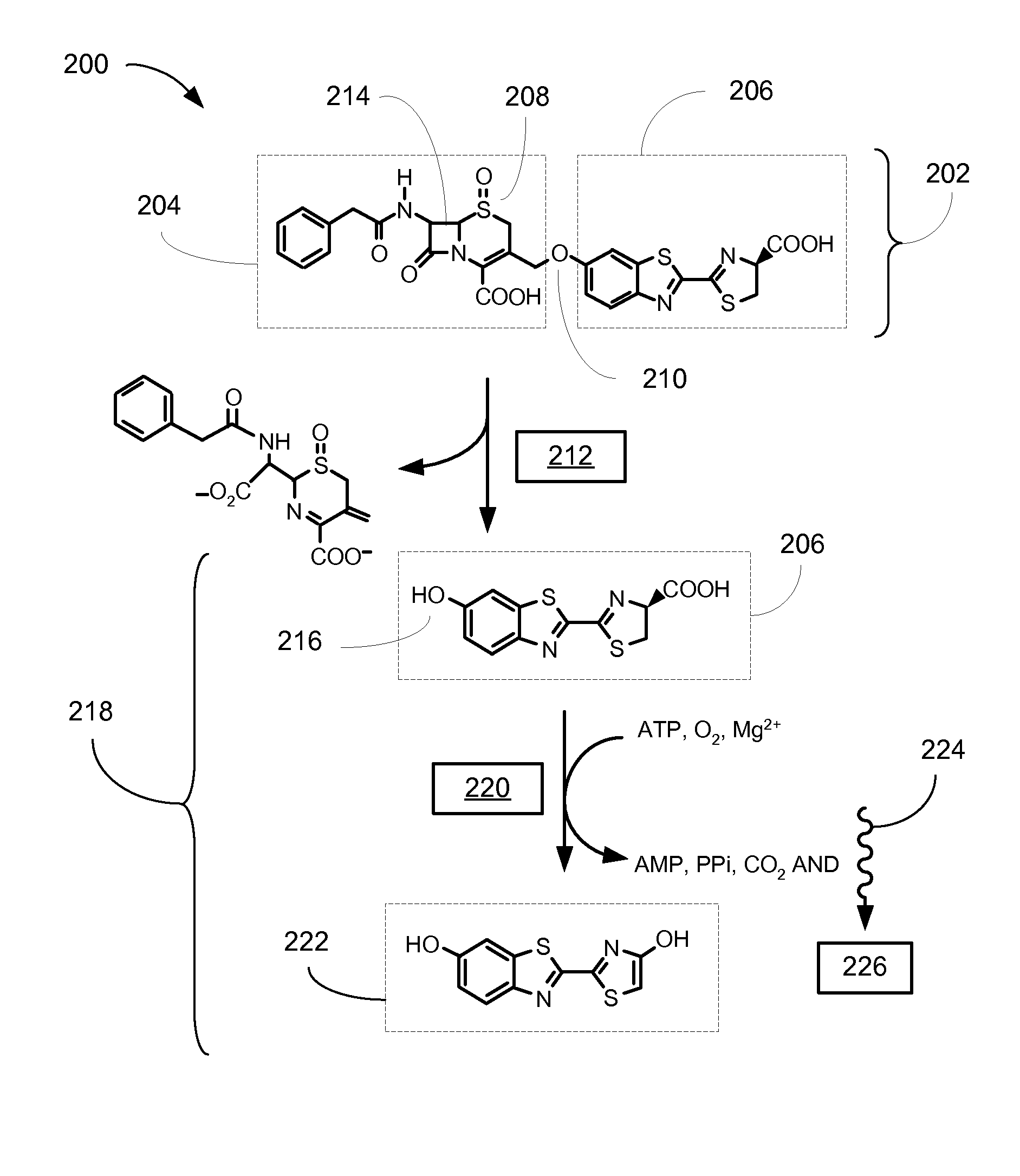Bioluminogenic assay system for measuring beta-lactamase activity
a bioluminogenic and activity-based technology, applied in the field of enzyme chemistry, can solve the problems of increasing global health problems such as bacterial resistance or immunity to antibiotics, reducing or eliminating the effectiveness of antibiotic molecule as a treatment for bacterial infections, and developing life-threatening conditions
- Summary
- Abstract
- Description
- Claims
- Application Information
AI Technical Summary
Benefits of technology
Problems solved by technology
Method used
Image
Examples
example 1
Bioluminogenic Substrate System Employing Cephalosporin and D-Luciferin
[0031]Referring now to FIG. 2, therein is shown a bioluminogenic assay system 200 for the detection of beta-lactamase activity in one embodiment of the present invention. As one embodiment of the bioluminogenic substrate 100 shown in FIG. 1, a bioluminogenic substrate 202 incorporates a cephalosporin molecule 204 as the beta-lactam antibiotic 102 shown in FIG. 1, and a D-luciferin molecule 206 as the bioluminescence initiating compound 108 depicted in FIG. 1. In this embodiment of the invention the sulfide group in the cephalosporin molecule 204 is oxidized to a sulfoxide functionality 208 to improve the stability of the bioluminogenic substrate 202. The chemical linkage 106 shown schematically in FIG. 1 is implemented by coupling the 3′ position of the cephalosporin molecule 204 to the 6-hydroxy group of the D-luciferin molecule through an ether bond 210.
[0032]In the first step of the two-step reaction used for ...
example 2
Detection and Imaging of the Tetrahymena Ribozyme-Splicing
[0043]Referring now to FIG. 7, therein is shown a schematic diagram illustrating a Tetrahymena ribozyme reporter 700 incorporating RNA fragments encoding the beta-lactamase enzyme 212. The Tetrahymena ribozyme reporter 700 incorporates a RNA fragment-I 702 encoding part of the beta-lactamase enzyme 212 and a RNA fragment-II 704 encoding the remaining part of the beta-lactamase enzyme 212. The Tetrahymena ribozyme reporter 700 is transfected into COS7 cells. A splicing process 706 joins the RNA fragment-I 702 to the RNA fragment-II 706, creating a complete RNA construct 710 encoding the beta-lactamase enzyme 212, and a ribozyme structure 708. Subsequently, a translation process 712 within the COS7 cells creates expression of the beta-lactamase enzyme 212 within the COS7 cells.
[0044]Referring now to FIG. 8, therein is shown a plot 800 showing the bioluminescence emission from intact COS7 cells transfected with ribozyme construc...
example 3
Use of Coelenterazine or it Derivatives for the Bioluminogenic Substrate
[0046]Referring now to FIG. 9, therein is shown a bioluminogenic assay system 900 for the detection of beta-lactamase activity in one embodiment of the present invention. A bioluminogenic substrate 902 incorporates the cephalosporin molecule 204 as the beta-lactam antibiotic 102 shown in FIG. 1, and a coelenterazine molecule 904 as the bioluminescence initiating compound 108 depicted in FIG. 1. In this embodiment of the invention the sulfide group in the cephalosporin molecule 204 is oxidized to the sulfoxide functionality 208 to improve the stability of the bioluminogenic substrate 902. The chemical linkage 106 shown schematically in FIG. 1 is implemented by coupling the 3′ position of the cephalosporin molecule 204 to the 6-hydroxy group of the coelenterazine molecule 904 through an ether bond 906.
[0047]In the first step of the two-step reaction used for the bioluminogenic assay system 900, the beta-lactamase ...
PUM
| Property | Measurement | Unit |
|---|---|---|
| excitation wavelength | aaaaa | aaaaa |
| bioluminescence | aaaaa | aaaaa |
| bioluminescence indicator | aaaaa | aaaaa |
Abstract
Description
Claims
Application Information
 Login to View More
Login to View More - R&D
- Intellectual Property
- Life Sciences
- Materials
- Tech Scout
- Unparalleled Data Quality
- Higher Quality Content
- 60% Fewer Hallucinations
Browse by: Latest US Patents, China's latest patents, Technical Efficacy Thesaurus, Application Domain, Technology Topic, Popular Technical Reports.
© 2025 PatSnap. All rights reserved.Legal|Privacy policy|Modern Slavery Act Transparency Statement|Sitemap|About US| Contact US: help@patsnap.com



